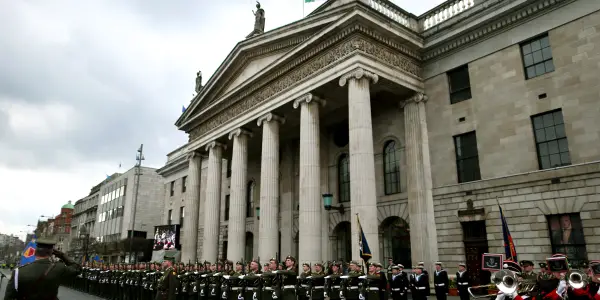The 1916 centenary celebrations planned over Easter weekend will honour the courage and ideals of the Rising and its leaders and reflect all of Ireland’s history, a Government minister has said.
With h undreds of thousands of people expected to line a 4.5km route across Dublin on Sunday, the unprecedented spectacle is being billed as the largest public celebration in the history of the state.
Some 3,722 Defence Forces personnel will march across the capital in front of military vehicles and wreath laying ceremonies will be held in the Garden of Remembrance, Glasnevin Cemetery, Kilmainham Gaol and the GPO.
Acting Minister for Arts, Heritage and the Gaeltacht Heather Humphreys said the events had been planned to honour the Rising and its leaders but also reflect Ireland’s diversity and identity.
“Each day of the weekend is anchored in a respectful commemorative ceremony, to remember those who lost their lives in the pursuit of self determination and democracy,” she said.
“While Sunday will be a day of solemn reflection, on Monday we will celebrate our Irishness, our diversity and our national identity in an incredible array of artistic, historical and culture events.”
Ms Humphreys added: “100 years on from 1916, Ireland is a democracy which has stood the test of time, despite considerable challenges.”
The commemorations begin on Saturday morning when Sabina Higgins, President Michael D Higgins’ wife, lays a wreath at the grave of Countess Constance Markievicz in Glasnevin Cemetery.
Following that, the President will lay a wreath in the Garden of Remembrance in honour of all those who fought and died for Ireland’s freedom.
And later on Saturday evening a special reception is being held in the RDS for relatives of those who fought in the 1916 Rising with a special address by President Higgins.
On Easter Sunday, the State ceremony will run in three parts.
Wreaths will be laid in Glasnevin at the Sigerson Monument, which honours the dead of 1916, and at the graves of Edward Hollywood, a silk weaver from the Liberties in Dublin who put together the Irish Tricolour in 1848, and the grave of Peadar Kearney, who wrote the lyrics to Amhran na bhFiann.
President Higgins will be in the Stone Breakers’ Yard in Kilmainham to lay a wreath on the site where the 1916 leaders were executed.
At 10am the massive parade involving 3,722 members of the Defence Forces, emergency services and army veterans will begin to weave its way along a 4.5km route from St Stephen’s Green to O’Connell Street and past the GPO on to Capel Street.
The ceremony will begin with the reading of the Proclamation, under the portico of the GPO, by an officer from the Defence Forces.
Two hours into the parade a key part of the 1916 ceremonial events takes place when the President lays a wreath at the main battlefield site on behalf of the people of Ireland.
Along the route, which is expected to be lined by more than 250,000 people, there will be 22 viewing screens and five setback areas where families can congregate.
The parade is expected to end at around 3pm.
On Easter Monday further commemorations are planned at each of the seven key battlefield sites in Dublin.
Wreath laying ceremonies, again open to the public, will take place at the 1916 garrisons including Boland’s Mill, the Jacob’s Factory on Bishop Street, Dublin Castle and City Hall, the Four Courts, the Royal College of Surgeons, Moore Street and at St James’ Hospital, which was the South Dublin Union 100 years ago.
Outside of Dublin simultaneous wreath laying ceremonies will be held in Athenry, Cork, Enniscorthy and Ashbourne.
Also on Easter Monday cultural events are planned in more than 200 venues across Dublin city centre including 500 free talks, exhibitions, debates, film, performances and dramatizations, with six outdoor stages and lots of activities for children and families.
Organisers have warned of massive demand for public transport and access to the city, particularly on Sunday.
Large viewing screens will be erected at the Garden of Remembrance and Glasnevin for the public due to limited space in some locations such as Kilmainham.
While the entire route of the parade will allow for pedestrian access, there will be restrictions around O’Connell Street because of the large numbers of 1916 relatives and other invited guests.
